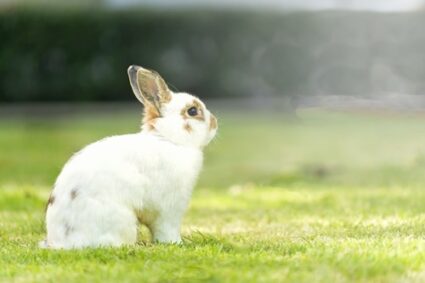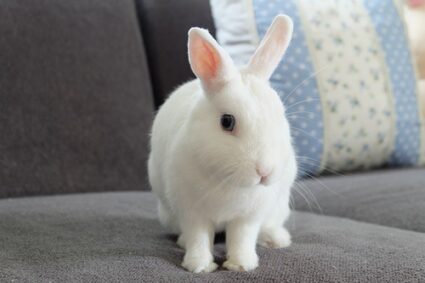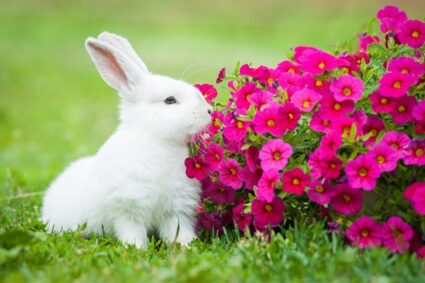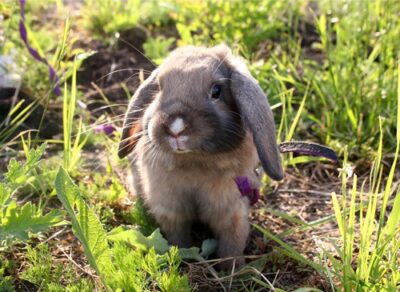The size of a dwarf rabbit (mini rabbit) makes them cute and adorable pets. A dwarf rabbit’s small size also means that it’s easier to handle compared to larger lagomorph breeds. A further advantage is that these small breeds live longer than larger breeds of rabbits.
Dwarf rabbits typically weigh between 1.5 and 3 pounds. Most mini rabbits fall within the 2 to the 2.5-pound range, and some can even be as big as 5 pounds, such as the dwarf lop rabbit.
Like other animals, dwarfism in rabbits is caused by a naturally occurring genetic mutation. Over time, the altered craniofacial structure and compact size have become a desired trait in rabbits.
Dwarf Rabbit Size Comparison
| Dwarf Breed | Weight |
|---|---|
| Netherlands Dwarf Rabbit | Under 2.5 lbs |
| Dwarf Lop Rabbit | 4.5 to 5 lbs. |
| Dwarf Lionhead Rabbit | Under 3.75 lbs |
| Dwarf Hotot Rabbit | Under 3 lbs |
| Columbia Basin Pygmy Rabbit | Under 1 lb |
| Mini English Angora Rabbit | Under 3.5 lb |
| Jersey Wooly Rabbit | 1-3 lbs |
| Britannia Petite Rabbit | 1½ – 2½ lbs |
| Miniature Cashmere Lop Rabbit | 3.5 lbs |
How Big Does a Dwarf Rabbit Grow?
On average, dwarf rabbits weigh between 2 to 2.5 pounds. However, a dwarf rabbit can be as small as 1 pound and as large as 5-5.5 pounds.
The smallest dwarf rabbit breed is the Columbia Basin Pygmy Rabbit which weighs no more than just 1 lb when fully grown. The average length of a Columbia Basin Pygmy Rabbit is 9 to 11 inches.
However, this Columbia Basin Pygmy Rabbit is a rare breed. The smallest domestic dwarf rabbit is the Netherland Dwarf. According to the American Rabbit Breeders Association, it weighs no more than 2.5 lbs when fully grown.
While many small rabbit breeds possess the dwarfing genes, rabbits such as the Britannia Petite Rabbit, do not. Such rabbits have a small and compact stature due to selective breeding of successively smaller generations. This process is called dwarfing in rabbits.
Most mixed breed small rabbits are categorized as false dwarfs because the rabbit has not inherited the dwarfing gene.
The biggest dwarf rabbit breed is the Mini English Angora Rabbit, which weighs between 5 to 6 pounds when fully grown.
Dwarf Rabbit Breeds
According to research by the Rockefeller Institute for Medical Research, dwarfism in rabbits is caused by a genetic mutation or deactivation of the HMGA2 gene.
The Netherland Dwarf is considered as the original dwarf breed, but there are many others.

Netherland Dwarf
The Netherland Dwarf is a tiny rabbit, with adults weighing between 1.75 to 2.5 lbs. The average length of a Netherland Dwarf is no more than 33 to 50 centimeters.
This tiny dwarf breed was first developed in the Netherlands by crossbreeding domestic breeds with a small wild rabbit. The color and appearance were standardized when the breed arrived in England.
The Netherland Dwarf has a short and compact body, with a small flat nose and short rounded ears. It has short, soft fur that comes in a wide range of colors, including, gray, white, black and brown.
In rabbits, dwarf breeds are rabbit breeds obtained from breeding the Netherland Dwarf (or another rabbit with a dwarf gene) with larger rabbits. Therefore, most dwarf breeds are slightly bigger than an average Netherland Dwarf and do not exceed 4 to 5 pounds.
Dwarf Lop Rabbit
The Dwarf Lop is a small-to-medium rabbit that weighs around 4.5 to 5 lbs. Dwarf Lops sold as pets may be larger than show rabbits, weighing up to 6.5 lbs. They have a substantial build with a wide and short body, giving them a compact body shape.
Dwarf Lops pose similarly to cats. They prefer to rest mostly on their hind legs and just slightly on their front limbs.
While the Dwarf Lop’s stocky body is enough to indicate that it is cute, its floppy ears are what makes the breed different from other dwarf breeds. This breed’s most coveted feature is its large, spoon-shaped and thick fur-covered ears that hang down on either side of the head.
Dwarf Lops may be solid-colored or have white patches on the legs, chest, and head. They have medium-length hair and a dense and soft coat.
Dwarf Lionhead Rabbit
The Dwarf Lionhead rabbit has a woolly mane surrounding its head, similar to a lion’s mane, which explains its name. Lionhead rabbits have a compact body and a high head mount. They typically weigh no more than 3.5 lbs, with ears averaging between 2-3 inches in length.
The dwarf Lionhead rabbit originated in Belgium when breeders decided to cross a Swiss Fox with a Netherland Dwarf. The resulting rabbit had a genetic mutation that caused long fur to appear around the head and flanks. This was later called the “mane” gene.
Lionhead dwarfs have two types of manes. One is a single mane, with a wispy, thin mane around the head, chin, ears and sometimes the chest. And the other is a double mane, which is much thicker than a single mane with wool on the flanks.
The most desired feature of a Lionhead rabbit is its thick, long coat. Owners have to keep the fur matt-free by brushing the fur at least once a week during non-shedding seasons. During shedding seasons, a lionhead rabbit will go through a molt and will need to be brushed every day to keep its fur clean.
Dwarf Hotot Rabbit
The Dwarf Hotot is a small-sized rabbit that weighs between 2.5 to 3.5 lbs when fully grown. This breed is known for its white coat and contrasting black eye markings. The Dwarf Hotot has a compact body with a short neck and round head.
The hindquarters of a Dwarf Hotot is rounded and in line with its wide shoulders. Its coat is dense, short and tiny and its ears are thick and short. The Dwarf Hotot has rollback fur, which means its fur remains upright when rubbed.
Contrary to popular belief, the Dwarf Hotot rabbit isn’t a smaller version of a Hotot. In fact, it was developed by crossing numerous breeds of rabbits with a regular-sized Hotot rabbit. Breeders used the White Hotot and the Netherland Dwarf to produce the Dwarf Hotot.
Columbia Basin Pygmy Rabbit
The Columbia Basin Pygmy Rabbit is the smallest rabbit breed in the world and can easily fit in the palm of your hand. It weighs no more than 1 pound and has a length of only 9 to 11 inches. The breed is easily recognizable thanks to its tiny ears and round, compact body.
Columbia Basin Pygmy Rabbits have strong, short legs and can hop at 15 miles per hour. Their big claws allow them to dig burrows and their tails are short and almost unnoticeable
This breed is an isolated population of the Pygmy Rabbit and is indigenous to a single region in Washington state.
Pygmy rabbits have populated the Great Basin area of the western United States for about 100,000 years. However, glacial movements separated the Columbia Basin Pygmy Rabbit population from the rest of its relatives at least 10,000 years ago. This led to genetic differences and a new kind of rabbit breed.
Unfortunately, the Columbia Basin Pygmy Rabbit is almost extinct and is now listed as an endangered species.
Mini English Angora Rabbit
The Mini English Angora rabbit is a small breed that generally weighs under 3.5 pounds when fully grown. It has a compact and well-rounded body type with ears that are ideally 2.5 inches in length.
The Mini English Angora rabbit has bright and bold eyes and comes in a variety of colors and patterns, including solid color, agouti (wild) and shaded patterns. Its wool is dense and often between 5 and 7 centimeters in length.
A Mini English Angora rabbit’s coat has slightly more guard hair than the undercoat. This makes the rabbit’s fur less susceptible to matting.

Jersey Wooly Rabbit
The Jersey Wooly rabbit is a smaller dwarf breed that weighs between 1-3 pounds. It has a compact body type and has small, erect ears about 2-3 inches long. This breed also has a square and bold head, giving it the name “Mug Head.”
Another name for the Jersey Wooly is the “No-Kick Bunny” because of its calm and docile behavior.
To keep a Jersey Wooly’s coat tangle- and matt-free, you need to brush its coat at least once a week during non-shedding seasons. During spring or shedding season, you’ll need to brush your bunny more often.
You don’t need to trim or clip a Jersey Wooly rabbit’s fur to maintain its wool. Spot clean it with a wet cloth if its fur gets dirty and never try to give it a complete bath to avoid stress and cardiac issues.
The Jersey Wooly was originally developed by breeding the French Angora rabbit with a Netherland Dwarf rabbit. This resulted in a miniature rabbit with woolly fur.
Britannia Petite Rabbit
The Britannia Petite rabbit is one of the smallest rabbit breeds with a bodyweight of 1.5 to 2.5 pounds during adulthood. What makes the Britannia Petit different from other breeds is its small, slender and fine-boned stature with an arched and hare-like physique.
The Brittania Petite evolved from Polish rabbits. In England, breeders would teach Polish rabbits to pose, for example, sitting up on the forefeet. This, along with selective breeding, resulted in a rabbit with refined bone structure and an upright stance.
The Brittania petite has a full-arch body. This means the arch starts at the base of the neck and continues to the base of the tail. When you look at it from the side, it should look like a quarter circle.
The Brittania rabbit also has large eyes with a wedge-shaped head, which almost makes it look like the eyes are protruding out of the head. It has short, erect ears and a short, soft coat that doesn’t need much grooming.
Miniature Cashmere Lop Rabbit
The Miniature Cashmere Lop has a compact and firm body structure and weighs no more than 3.5 pounds when fully grown. Despite being small, the Miniature Cashmere Lop has a powerful body and is described as broad and well-muscled with a little visible neck.
The rabbit’s rump is well-muscles and well-rounded as well, and the chest is deep and broad. The front legs of the Miniature Cashmere lop are short, thick and straight, and the hind legs are short and powerful. The tail is also strong and well-furred.
The Miniature Cashmere Lop has hanging ears that are thick, broad and rounded at the ends. The rabbit carries its ears close to its cheeks. This gives it a horseshoe-like appearance when seen from the front.
As its name implies, the Miniature Cashmere Lop rabbit has a dense and silky coat. The coat hands down naturally and is often 1.5 to 2 inches in length.

What Size Cage is Best for a Dwarf Rabbit?
Even for small dwarf rabbits, such as the Netherland Dwarf, the larger the cage size, the better. A bigger cage will give your rabbit enough room to stretch, play, and exercise in. It should have plenty of space for rest, food, water, and elimination.
The smallest cage for a dwarf rabbit is 18×24 inches, with a height of at least 14 inches. If you’re adding a litter box to the cage, add this to the size of the box.
Regardless of how spacious your rabbit’s cage is, a dwarf rabbit needs plenty of exercise out of its enclosure to be healthy and content. Avoid letting dwarf rabbits roam around outdoors as this increases their risk of being hunted by predators. Instead let them play inside your home, in a rabbit-proofed space.
If you want to give your dwarf rabbit some outdoor playtime, let it play and hop around in a safely enclosed section of your yard or garden. Make sure you supervise your rabbits at all times when they’re out of their cage.
Materials for a Dwarf Rabbit Cage
Wire cages are best for dwarf rabbits because they are easy to clean, durable, and offer ample airflow. They also give you easy visual contact with your pet rabbit.
Wood is ideal for the frame of a wire cage. However, you’ll want to avoid all-wood enclosures as they provide poor ventilation. When choosing wood, look for a variety that will be thick enough to tolerate some gnawing without losing its structural integrity.
Avoid plastic cages as dwarf rabbits can easily chew through the cage. This does not only allow your rabbit to escape, but it also makes it susceptible to getting ill from consuming plastic.
Avoiding glass aquariums is also advisable because of the lack of ventilation. Furthermore, the slick nature of glass enclosures can cause your rabbit to develop splay feet as a result of poor traction.
Dwarf Rabbit Cage Flooring
Wire floors are safest and easiest to clean when it comes to housing dwarf rabbits. Your rabbit’s urine and poop will drop away from its body, keeping your rabbit clean and healthy.
Sometimes, wire flooring may cause sore hocks in rabbits due to the constant pressure of the wire on the feet. You can easily avoid this by placing a wooden board or a rubber resting mat on the floor in the corner of the cage. Wood floors are easier on the feet, but they can trap feces and urine.
Rabbits may sit on their poop, even if you provide them with a good layer of bedding. This can result in infections on the feet due to constant contact with the feces. The ammonia odor from urine being trapped in the wood can also lead to upper respiratory infections in rabbits.
If your dwarf rabbit’s cage has a wooden floor, be sure to clean the cage every day to prevent potential complications.
Dwarf Rabbit Care And Behavior
Dwarf rabbits can be fearful and skittish. Allow your dwarf rabbit to acclimatize to new environments, people, and play on its own schedule to prevent any isolated behavior.
Dwarf rabbits are fond of being caressed behind the ears by owners they trust. Even though they tend to be nervous in the beginning, they are docile, sociable and affectionate pets.
Because of the dwarf rabbit’s small size, it can be afraid of bigger pets. They’re best socialized from when they’re babies. You’ll also want to make sure that other pets in your home and your dwarf rabbit have a respectful size difference. This will prevent your bunny from accidentally getting hurt.
Your dwarf rabbit must have a calm and quiet place to rest in when you leave it on its own. Dwarf rabbits need to be kept away from direct sunlight, drafts, and loud noises. Keep other pets from approaching your rabbit until it gets used to them being around.
Dwarf rabbits are not child-friendly pets. They’re better suited for adults and elderly individuals. This is because dwarf rabbits are very small, and rough handling can easily fracture your rabbit’s back.
Include plenty of toys for your dwarf rabbit to play with so that it doesn’t get bored. Offer your rabbit something to nibble on and make sure all toys are suitable for rabbits.
When it comes to grooming, brush your dwarf rabbit’s coat regularly to remove unwanted dead hair. Although rabbits clean themselves, you may have to wipe clean an occasional dirt mark once in a while with a damp cloth. Never bathe any rabbit as this can cause stress, shock, or cardiac arrest.
The cage should have a good layer of shavings to soak up any urine. The enclosure should also have a rabbit water bottle, food, hiding places, and a nest for your rabbit to rest. Anytime, you take your dwarf rabbit out of its cage, ensure that it is continually supervised.
Pay attention to the quantity and quality of food you give your dwarf rabbit. Feed must be adjusted according to the rabbit’s age and size.

